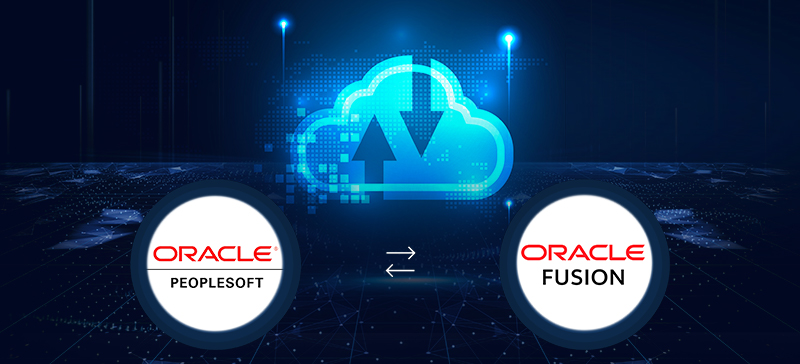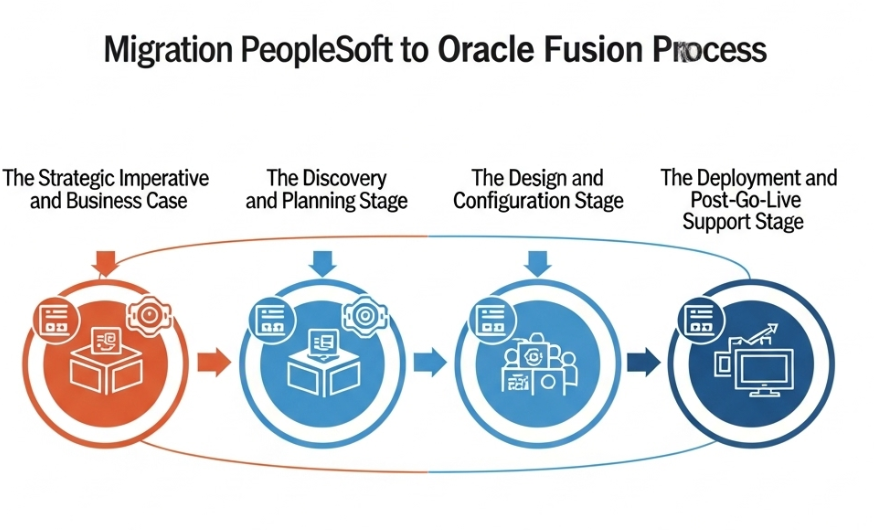
In today's fast-paced digital landscape, enterprises are constantly seeking ways to modernize their operations, enhance agility, and reduce costs. For organizations that have long relied on on-premise ERP systems like Oracle PeopleSoft, the shift to a more flexible, scalable, and innovative platform is not just an option but a strategic imperative. The most logical and powerful evolution for these businesses is a PeopleSoft to Oracle Fusion transition. This comprehensive guide will walk you through the journey of migrating from Oracle PeopleSoft to Oracle Fusion Cloud, highlighting the key steps, best practices, and the immense benefits of this transformation.
The decision to embark on an Oracle PeopleSoft to Oracle Fusion Cloud Migration is driven by several factors. While PeopleSoft has been a reliable cornerstone for many organizations, its on-premise nature can lead to high maintenance costs, complex upgrades, and limited scalability. In contrast, Oracle Fusion Cloud offers a modern, cloud-native architecture that provides continuous innovation, automated updates, and a unified platform for all business functions, from Human Capital Management (HCM) to Enterprise Resource Planning (ERP). This move represents more than just a technology change; it is a fundamental Legacy system modernization that can unlock new levels of efficiency and strategic value.

Figure 1: A Step-by-Step Guide to Oracle PeopleSoft to Oracle Fusion Cloud Migration
Before diving into the technical aspects, it's crucial to establish a solid business case for the Oracle Fusion Cloud Migration. This involves a thorough analysis of your current PeopleSoft landscape, identifying pain points, and mapping them to the benefits of the new platform. A successful ERP cloud migration strategy starts with a clear understanding of the "why." What are your business goals? Are you looking to streamline processes, improve data analytics, or enable a more mobile workforce? The Benefits of migrating Oracle PeopleSoft to Oracle Fusion Cloud are vast, including reduced TCO, enhanced data security, and access to cutting-edge technologies like AI and machine learning.
The transition from a legacy system is not without its challenges. The shift to a new platform requires careful planning, stakeholder buy-in, and a clear vision. This is where a Real-world guide to Oracle PeopleSoft to Oracle Fusion transformation becomes invaluable. It helps you navigate the complexities and ensures that the project delivers on its promises.
The first phase of any successful migration is discovery. This is where you conduct a detailed assessment of your existing PeopleSoft environment. This includes reviewing customizations, integrations, and reports. The goal is to determine what can be retired, what needs to be re-platformed, and what can be leveraged in the new cloud environment.
This phase sets the foundation for the entire project. Skipping or rushing through it can lead to significant delays and budget overruns later on. A well-defined roadmap for your Step-by-step Oracle ERP migration for enterprises is your most important asset.
Once the planning is complete, the focus shifts to designing and configuring the new system. This phase is where the blueprint from Phase 1 comes to life.
The final phase is the culmination of all your hard work. This is when the new system goes live, and the old one is decommissioned.
Throughout this process, several key terms and concepts are at play. An ERP migration is a complex undertaking, and having a solid understanding of the terminology is vital. The transition from Oracle PeopleSoft is a journey towards a more modern, efficient, and scalable future with Oracle Fusion Cloud. This is an Oracle PeopleSoft upgrade to Fusion in spirit, but a full-scale transformation in practice.
The project is built on an End-to-end Oracle PeopleSoft to Oracle Fusion Cloud migration roadmap that guides you from the initial assessment to post-implementation support. This roadmap is a living document that needs to be adapted to your specific business needs. The ultimate goal is to leverage the full power of a Cloud ERP, including features such as business process automation, which is a core strength of the Fusion Cloud platform.
Once the migration is complete, your organization will be operating on a state-of-the-art platform that is ready for the future. The Oracle Cloud ERP strategy after PeopleSoft deprecation is about continuous innovation and leveraging the new capabilities of the cloud. With Oracle Fusion Cloud implementation for former PeopleSoft users, you can unlock benefits like advanced analytics, improved user experience, and a lower total cost of ownership. The system's ability to integrate seamlessly with other Oracle and third-party solutions provides a powerful foundation for future growth.
This is a journey that requires careful planning, a clear strategy, and a strong partnership with a knowledgeable implementation partner. By following these steps and focusing on a well-defined roadmap, your organization can successfully navigate the complexities of this transformation and emerge stronger, more agile, and better equipped to compete in the digital age. This is the Best practices for Oracle PeopleSoft to Fusion Cloud transition for modern enterprises.
The journey from Oracle PeopleSoft to Oracle Fusion Cloud is a significant investment in your company's future. It’s an investment in a platform that will not only meet your current needs but also empower you to innovate and grow for years to come. With this step-by-step guide, you are now equipped with the knowledge to begin your own transformation journey.
The journey from Oracle PeopleSoft to Oracle Fusion Cloud Migration is more than just a technical upgrade; it's a strategic move that positions your enterprise for long-term success in a competitive digital landscape. By following this structured, step-by-step approach, organizations can navigate the complexities of this transition with confidence. The move from a legacy system to a modern, cloud-native platform like Oracle Fusion Cloud is an investment in agility, innovation, and efficiency.
1. What is the main advantage of migrating from PeopleSoft to Oracle Fusion Cloud?
The primary advantage is modernization. Oracle Fusion Cloud offers continuous innovation, automated updates, enhanced security, and a unified platform for all business functions. It reduces high maintenance costs associated with on-premise PeopleSoft, provides better scalability, and enables advanced analytics and AI capabilities, positioning the organization for future growth and agility.
2. How long does a typical Oracle PeopleSoft to Oracle Fusion Cloud migration project take?
The duration varies significantly based on your organization's size and complexity. Factors like the number of modules, data volume, and the extent of customizations in your PeopleSoft environment play a major role. A typical migration can range from 9 to 18 months, with larger, more complex enterprises potentially taking longer. A thorough discovery and planning phase is key to setting a realistic timeline.
3. What are the biggest challenges to be aware of during the migration process?
Key challenges include managing a large-scale change management program to ensure user adoption, handling complex data migration from the legacy system, and re-platforming intricate integrations. Customizations in PeopleSoft can also be a challenge, as they often need to be re-evaluated and simplified to fit the cloud-native model. A solid strategy and clear communication are essential to overcome these hurdles.
4. Will all my data from PeopleSoft be migrated to the new Fusion Cloud system?
The data migration strategy is a critical part of the planning phase. Not all historical data needs to be moved. Organizations typically migrate recent and critical operational data, while archiving older, less frequently accessed information. This approach streamlines the process, reduces complexity, and ensures the new system starts with clean, relevant data.
5. Is it necessary to hire an implementation partner for this type of migration?
While it's possible to manage some aspects internally, hiring an experienced implementation partner is highly recommended. Partners bring deep expertise in both PeopleSoft and Oracle Fusion Cloud, providing a proven methodology, specialized tools, and best practices. They can help you navigate complexities, mitigate risks, and ensure a smooth, on-time, and on-budget transition, maximizing your return on investment.